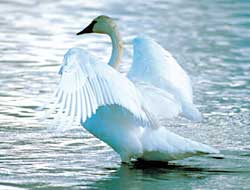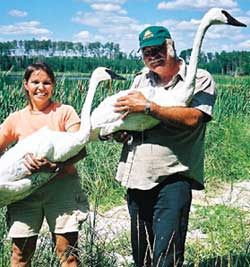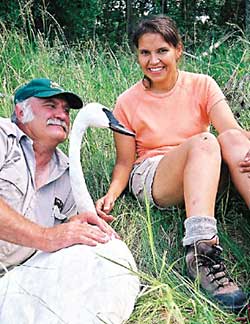|
Bringing back nature's true
musicians:
It's migration time again for our waterfowl and among them you may see North America's largest waterfowl: the majestic trumpeter swan. These beautiful white swans are hard to miss flying through Alberta's skies with mature birds weighing up to 14 kg. and having a wingspan up to 2.5 metres, comparably larger than tundra swans. If you are fortunate enough to live along their migration path then you may see and hear the resonant trumpet-like call of the same loyal breeding pairs for 20 years, as they make their way south for the winter with each successive year's offspring. A trumpeter female produces young when she reaches breeding maturity at three to six years old. She can continue to breed for 12 to 15 years and a breeding pair will hatch, on average, five cygnets a year. Unfortunately, because of an approximate 50 per cent mortality rate of cygnets in their first year of life and due to natural and human dangers to mature swans, it takes several decades to re-establish populations lost by over hunting and habitat loss. Present day factors limiting trumpeter swan survival include: habitat loss, human disturbances, collisions with power lines, poisoning from lead shot ingested while feeding, and depredation. These are only some of the challenges faced over the past 15 years by biologists and field staff working on the Trumpeter Swan Reintroduction Program at Elk Island National Park (EINP).
I have spent many hours monitoring these impressive birds in EINP and have assisted in the capture and collaring of sub-adult birds. Trumpeter swan re-introduction interpretation programs have also formed a large part of my duties over the past few years. Interpretation is a very important part of the program, reaching out to the general public, school groups and special interest groups. Also directly involved in the program are the Friends of Elk Island Society (FEIS). This is a non-profit association that co-operates with Parks Canada to promote understanding, appreciation and respect for Elk Island National Park. In order to better comprehend the need for trumpeter swan management, a better understanding of their history is needed. Once thought to be a tasteful gourmet meal, the trumpeter swan provided a basic food staple for many early pioneers in our country. There was also a high demand for feathers, bed quilts and pen quills, hats and powder puffs.
Canada's Endangered Species List (COSEWIC) supported recognition of the need to protect the swans in 1978 when trumpeters were placed on the 'vulnerable' list. The birds were removed from the COSEWIC list in 1996, but remain on Alberta's threatened species list as 'vulnerable'. The trumpeter swan is in fact still extirpated from many parts of its former range east of the Rocky Mountains. In 1983, Alberta Fish and Wildlife proposed a trumpeter swan re-introduction program to diversify the summer and breeding range in the province. In response to this proposal Parks Canada and the CWS initiated the present reintroduction program in EINP during 1987. Elk Island National Park was recognized as an ideal re-introduction site because it falls within the historic breeding area of the trumpeter. Other important factors include the many non-accessible and remote lakes that minimize disturbance during the program establishment years and into the future. The park also has the necessary legislation (National Parks Act and Regulations) and personnel (Park Wardens like Rob Kaye) to protect the swans. When swans are needed for re-introduction purposes, an aerial survey of the Grande Prairie area is conducted in order to determine trumpeter swan population numbers, breeding pairs and their general locations. Next, a reconnaissance helicopter is used to confirm a breeding pair's location and to determine cygnet numbers. If there are four or more cygnets identified at one nesting site, then two are chosen for an EINP foster family. Of course two cygnets will remain with their parents to prevent stress and retain family structure. The capturing is done during the molting period of the swans to ensure abandonment does not take place. Program workers determine which Elk Island lakes are being used by the sub-adult swans for staging on their migratory route before any capture plans are carried out further north in Grande Prairie. This is very important. Cygnets captured in Grande Prairie must have sub-adult swans to foster with in the park and sub-adults must use the same lake for staging over two consecutive years before a decision is made to capture and foster the cygnets. Once the decision is made as to which cygnets will be captured, the reconnaissance helicopter hovers over the swans and a large salmon fishing net is used to capture the cygnets. The cygnets are quickly brought to a staging area to be weighed, measured, banded and collared. The leg bands and collars, provided by Canadian Wildlife Service, are a viable source of information, providing age, sex, weight and fledging locations of the captured swans. Once swans have been collared and transported by park wardens and staff to their predetermined homes and foster parents in EINP, monitoring begins. Because of the strong paternal instinct of trumpeters, the adoption to sub-adult trumpeters usually occurs immediately. Once the successful adoption is completed, the monitoring continues for the remainder of the trumpeter's life at EINP. Over the last few years monitoring efforts in the spring have been increased in order to accurately identify the number of swans returning to the park. It is important to monitor the swans as soon as they begin arriving in the park usually between mid to late April. The following information is obtained through early spring monitoring:
Fall monitoring is carried out in much the same way as was done in the spring and summer mostly by ground with supplemental air monitoring if necessary. The information obtained through fall monitoring focuses primarily on the numbers of swans that have survived through to the migration period in October. By all accounts the re-introduction of the trumpeter swans into EINP has been a very successful program. In total, 27 of the large birds now reside within the park's boundaries. Three nesting pairs reared a total of 10 cygnets in 2002 and even greater successes are expected in 2003 when more females are expected to reach the age of sexual maturity. Now that's some feather in the park's proverbial cap considering that 1998 was the first year in more than 100 that a breeding pair of trumpeters was successful in raising their four cygnets to the fall migration. If you would like further information or history about trumpeter swans please contact Rob Kaye at Elk Island National Park, Gerry Beyersbergen with CWS, or Denise Hammel at Friends of Elk Island Society. |
|
|



